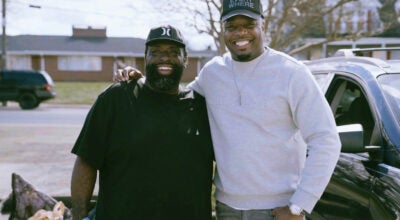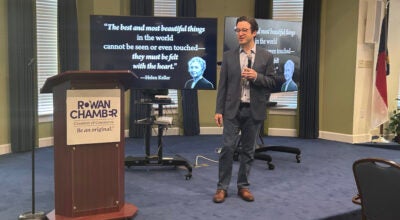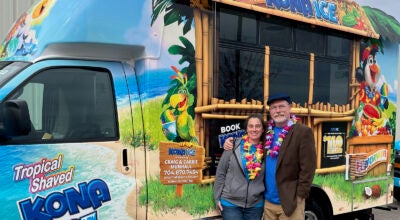Cheerwine flowing from Salisbury to Virginia on way to across the nation
Published 12:00 am Saturday, March 31, 2012
By Emily Ford
eford@salisburypost.com
SALISBURY — After Cheerwine’s successful debut last year in Memphis, Atlanta and Florida, new partner Pepsi will push the Salisbury soft drink into Virginia.
It’s big news for Cheerwine, which aims to land on grocery store shelves and in vending machines in all 50 states by 2017, a century after L.D. Peeler created the cherry-flavored beverage.
Already in many Virginia stores, Cheerwine will appear in soda fountains and vending machines alongside Pepsi starting May 7. Pepsi Beverages Co. has exclusive rights to manufacture and distribute Cheerwine in Virginia, as it does almost everywhere Cheerwine is sold outside North and South Carolina.
Without Pepsi, Cheerwine could not become a national soft drink.
Although the concentrate — or “secret sauce,” as the company calls it — is still made in Salisbury and always will be, CEO Cliff Ritchie said, Cheerwine needed a soft drink giant with nationwide reach to produce and bottle the soda pop.
“We are certainly encouraged by the way Pepsi has embraced Cheerwine,” Ritchie said.
Pepsi tested Cheerwine in three Tennessee markets in early 2011 and liked what it saw, said Tom Barbitta, Cheerwine’s vice president of marketing.
Cheerwine met or exceeded all performance goals, he said.
The partnership moved into Memphis, Atlanta and Florida in October 2011, which more than doubled Cheerwine’s footprint and gave the drink exposure to 30 million additional consumers.
Within four months, Cheerwine became the second most popular soft drink in the two dining halls at the University of Florida where it is served, behind Pepsi.
More than 600 college students — consumers in the crucial 18-to-24-year-old demographic— showed up for a Cheerwine launch party.
“The brand is in a very dynamic state right now,” Barbitta said. “It’s very much on the move.”
For people in North Carolina who have enjoyed the drink for generations, it may be hard to imagine the excitement the burgundy-colored bubbles cause when 95-year-old Cheerwine appears as the new kid on the fountain.
“The brand has a magical quality about it,” Barbitta said.
Cheerwine’s Salisbury roots give the brand “stickiness, family-ness, southerness and independence,” he said.
Compared to the big three soft drinks — cola, lemon-lime and yellow — Cheerwine has an underdog, little-guy quality that resonates.
With no connection to Wall Street, the slogan “Born in the South. Raised in a glass” and ambassador Miss Cheerwine dressed in denim shorts and a midriff-baring top, Cheerwine stands for different values than other soft drinks, Barbitta said.
“The brand has absolutely no swagger,” he said.
And when consumers discover the Cheerwine story — how the drink has been in the same family for five generations — “that’s when people really start to get excited,” he said.
Soda drinkers are thirsty for something different, Barbitta said. The soft drink industry has been, well, a little flat lately.
“There just hasn’t been a lot of excitement coming from the big guys,” he said.
When Cheerwine shows up on a fountain or in a vending machine, the oddly named, super-sweet concoction causes a stir.
Retailers will sell 3 percent more soda of all kinds by adding Cheerwine to their fountain line-up. Vending machine will generate about $133 more overall with a Cheerwine button.
Much like Apple and Starbucks, Cheerwine connects with people on an emotional level, Barbitta said. The brand lives in their heart, not their head.
“More than a brand-mark or a trademark, I call it a love-mark,” he said. “It’s loyalty beyond reason.”
People who love Cheerwine will drive out of their way, wait longer in line and spend more money to satisfy their craving.
“And when it’s not available, that makes consumers want it even more,” Barbitta said.
Yet Barbitta argues that making Cheerwine more readily available, even in all 50 states, will not diminish the brand’s allure or quell the excitement surrounding the drink.
It’s not an uncommon concern.
“A lot of people say when you are national, you are going to lose your mojo,” Barbitta said.
He disagrees. As long as Cheerwine remains independent and family-owned, the brand can grow “much, much bigger and still retain the magic,” he said.
Ritchie said Cheerwine’s goal from Day One always has been to go national. It’s just taken 95 years.
Cheerwine’s enthusiastic reception throughout the South has not surprised the CEO, but introducing the drink to other regions of the country could prove more challenging, he said.
“The further we get from home base, we will see how readily Cheerwine is accepted,” Ritchie said.
As Cheerwine moves north and west, the marketing strategy will not change, Barbitta said. And neither will the company that was born in Salisbury.
“No matter how big or far away from Salisbury we may go,” he said, “as long as we remember where we come from, we should be OK.”
Contact reporter Emily Ford at 704-797-4264.
By the bottle
Cheerwine is sold by the bottle in Cracker Barrel
restaurants and Fresh Market groceries across the
country, as well as independent coffee shops, pizzerias and bars. The company says the glass bottle — Cheerwine’s “secret weapon” — has been a good way to introduce people to the drink and leave them wanting more.




